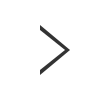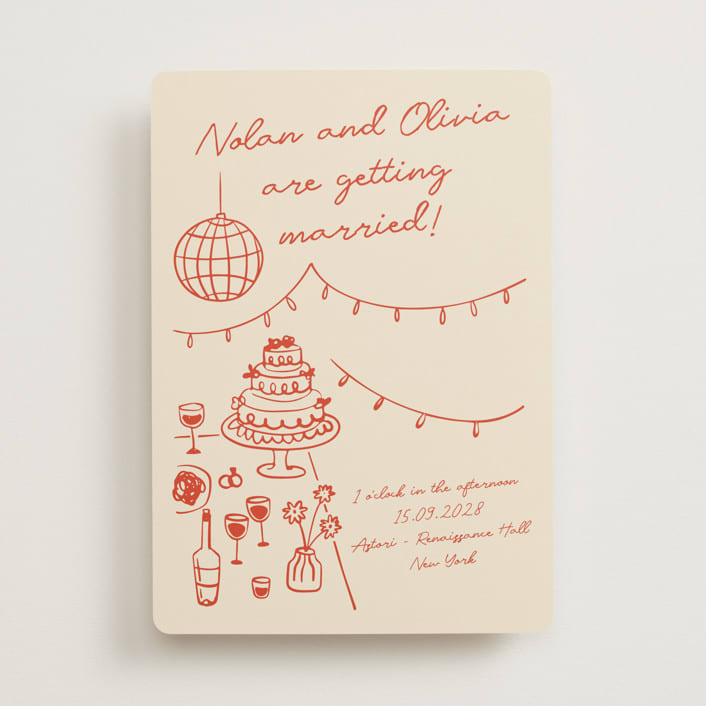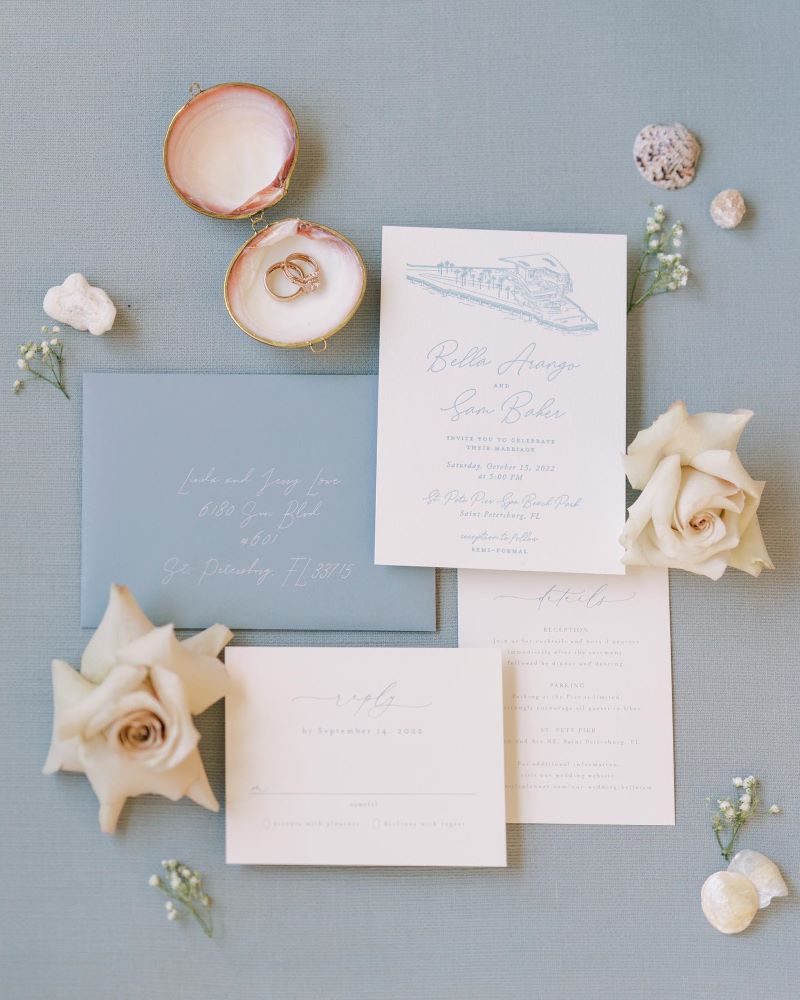You've locked in your date — congrats on getting your first big wedding planning item done! Now, as you dream up what type of decor will look best at your venue, pop the question to your bridesmaids, and start shopping for your wedding wardrobe, it’s time to start thinking about your wedding stationery.
As with all things wedding-related, the traditions you choose to embrace and the ones you choose to skip are totally up to you — and that’s true for save the dates and invitations! In this article, you'll find everything you need to know about save the dates and invitations so you can decide what works best for you, your wedding vision, and your budget. So keep reading to learn the differences between the two, including what information they typically include, when to send them, who to send them to, and how to make the most of your stationery to create a beautiful first impression.
Differences between save the dates and invitations
The core purpose of both save the dates and invitations is to communicate your wedding details to guests, but there are some important differences.
Save the dates give guests an early heads-up about your wedding date and general location so that they can plan ahead for travel, time off, or childcare. They are also an opportunity to share your engagement in a fun way. Typically, these are sent about 9 months before your wedding date.
On the other hand, your invitations do more: they officially invite your guests, and share all the details of your big day, like exact times, addresses, and dress code. RSVP instructions and other enclosure cards (such as directions to the ceremony or reception location, weekend itineraries, invitations to the rehearsal dinner, etc.) are also included when you send out your invitations. Typically, invitations go out 6-8 weeks before you say “I do.”
In short, you can think of save the dates as the friendly "just so you know," and invitations as the formal "here's everything you need to attend."
What to include on save the dates vs invitations
The level of detail you choose to share about your day in both your save the dates and wedding invitations is totally up to you. Below, we’ve outlined what information each typically includes, but you can choose to omit many of the finer details if they don’t apply to your wedding.
| Save The Dates | Wedding Invitations | |
|---|---|---|
| Basic Info | Names of the couple | Names of the couple (full names for a formal invitation) |
| Event Logistics | Wedding website (if available) | Ceremony & reception addresses Start time(s) RSVP instructions Hotel info Itinerary for multi-day events Meal selection details |
| Optional Details | (Often omitted at this stage) | Dress code Plus-one policy Registry info Parent names (if hosting) |
| Tone & Etiquette | Typically casual or celebratory No RSVP expected |
Formal or thematic, depending on tone RSVP expected (online or by mail) Notes on whether children are welcome or not |
Save the date and invitation formats & stationery options
Your stationery choices are part of how you tell your story. If you love a little shine, foil-pressed lettering might be your thing. Letterpress on cotton paper could be a perfect match if you prefer something more tactile and elegant. You can also explore digital or embossed printing styles depending on your vibe. And don’t overlook the shape — scalloped edges, arches, and other trims can add a fun or formal touch that feels more you.
Save the date formats
Save the dates are typically much simpler than wedding invitations (though, again, the sky's the limit with all things wedding-related!). Usually, the save the date consists of an envelope containing a single card that shows off your favorite engagement photo — or a few photos, depending upon the design — along with your wedding date and location.
That said, save the dates come in several formats and styles, all of which offer lots of opportunities for personalization. Here are a few options you might love:
- Single Card: A classic 5” x 7” card with your photo, date, and location.
- Postcard: A budget-friendly option you can mail without an envelope.
- Magnet: A keepsake guests can display on their fridge.
- Vellum Wrap: A translucent overlay printed with your details layered over a photo.
- Photo Mount: A combination of semi-gloss photo paper and classic cardstock to show off your engagement photos.
For more inspiration, check out Minted’s save the date inspiration guide.
Invitation formats
While wedding websites have allowed couples to pair back their printed invitations if they want to, most still choose to send an invitation suite that consists of multiple cards so they can share all of the details of their big day with guests.
Here are the main pieces of stationery you might include in your invitation suite:
- Main Invitation: This card lists the date, times, and locations of your ceremony and reception, and sets the tone for your celebration.
- RSVP Card & Pre-Addressed Envelope: Guests fill this out to let you know whether they'll attend, if they're bringing a plus one, and what meal option they prefer.
- Reception Card: If your reception is at a different location, this card shares details and directions.
- Itinerary Card: For multi-day weddings, this outlines the schedule of events like welcome parties and brunches.
Personalize your suite with custom monograms or crests, envelopes, liners, and belly bands to keep everything organized and add an elegant finishing touch. You can also include a link to your wedding website so guests can easily find extra details, RSVP online, and explore travel information.
Save the date and invitation wording examples
Clarity is key, no matter how you choose to word your wedding invitation, but that doesn't mean you have to be generic. There are plenty of ways to personalize your wedding invitation wording and save the date wording so it reflects both your wedding style and your personality as a couple. Here are some examples you can adapt to your style:
Formal
Save the Date:
Please save the date for the wedding of Katherine and Thomas.
May 14, 2026 | Charleston, South Carolina.
Wedding Invitation:
Together with their families, Katherine Elizabeth James and Thomas Michael Reynolds request the honor of your presence at their wedding celebration.
Saturday, May 14, 2026 5:00 PM Magnolia Gardens Charleston, South Carolina Reception to follow. Please RSVP by April 1, 2026.
Casual
Save the Date:
Mark your calendar — Mia and Jordan are getting married!
September 12, 2026 • San Diego, CA.
Wedding Invitation:
Join us to celebrate the wedding of Mia and Jordan!
Saturday, September 12, 2026 | Ceremony at 4:00 PM | Reception to follow.
Modern minimalist
Save the Date:
Save the date: Evan + Noah | October 17, 2026 | Brooklyn, NY.
Formal invitation to follow.
Wedding Invitation:
Evan Morgan and Noah Lee invite you to their wedding.
October 17, 2026 | 4:30 PM | Prospect Park Boathouse.
Destination wedding
Save the Date:
Pack your bags — we’re getting married in Tuscany!
Save the date: June 21, 2026.
Olivia & Max.
Wedding Invitation:
Please join us for the wedding of Olivia Parker and Max Jacobs.
June 21, 2026 | Villa La Selva, Tuscany, Italy | RSVP by March 15.
Timing: When to send each
Most couples mail out their save the dates about 8 to 12 months before the big day. But you can send them as soon as you've booked your venue and picked your wedding date. This timeframe gives everyone plenty of time to plan travel, budget for expenses, and block off time on their calendars.
Wedding invitations usually go out about 6 to 8 weeks before your wedding date. If you have many guests traveling internationally or planning complicated trips, you can send them up to 12 weeks early. Sending invitations a little later lets you finalize all your details and timelines while giving everyone enough time to RSVP.
What your guests need to do
Beyond displaying it on their fridge, nothing is expected of your guests when they receive your save the date.
On the other hand, wedding invitations typically require your guests to take a few steps after receiving them. Here are some of the most common actions you might ask them to do:
- RSVP by mail or online
- Indicate if they're bringing a guest
- Select their meal preference
- Share any dietary restrictions
- Request a song or leave a message
Traditionally, RSVPs were mailed back to you (which is why RSVP cards are part of most invitation suites), but many couples now direct guests to their wedding website to reply. This helps you track everything in one place.
Expert Tips and tricks for leveling up your invitations and save the dates
Your save the dates and invitations should communicate two things: the details about your big day that your guests need to know, and the tone of your celebration. Use these tips to avoid confusion, make your guests feel welcome, and ensure every piece of your wedding stationery reflects your style.
1. Reflect your wedding style
Choose colors, fonts, and design elements that match your theme, whether it's modern, classic, rustic, or something unique to you. Think about how you want guests to feel when they open your envelopes.
2. Keep the tone and formality aligned
Use consistent wording, voice, and level of formality across all your pieces so your stationery feels polished and intentional. You can decide if you want a very formal approach (like traditional wording and etiquette) or a more relaxed tone that feels like you. Adding a short line that hints at your personalities also helps.
3. Be clear with dates and locations
Make sure your guests always know exactly when and where to show up. Double-check dates and addresses on everything you send. Include a clear timeline if you have multiple events, and consider repeating the essentials in your RSVP card or website so nothing gets missed.
4. Repeat visual elements
Carry through small details like monograms, floral illustrations, or accent colors. When you repeat design touches, you make everything feel more coordinated. You can also consider including the same paper texture, foil accents, or even envelope liners to tie everything together.
5. Double-check names and addresses
Review spelling and details so everyone feels included and no invitations go astray. Ask a friend or family member to proofread your guest list. Even small mistakes can cause confusion or hurt feelings.
6. Preview the pairing before sending
Lay out all your pieces together or use digital proofs so you can see how they look as a set. This helps you spot anything that feels out of place and gives you confidence that everything matches perfectly.
7. Use your website for extra details
Include travel tips, registry links, hotel blocks, and schedule updates so guests can easily find everything they need. (Pro tip: Many of Minted’s wedding invitation and save the date designs feature a coordinating wedding website theme so every touchpoint of your big day can stay cohesive.)
Frequently asked questions about save the dates vs invitations
Here are some common questions couples ask when planning their wedding stationery.
What’s the difference between save the dates and invitations?
Save the dates are an early heads-up that shares your wedding date and general location. Your invitations will follow later with all the details guests need to RSVP and attend. Think of save the dates as the preview and invitations as the full information.
Do I need to send both a save the date and a wedding invitation?
It's traditional to send both, so guests have plenty of notice and a formal invitation. Sending a save the date gives everyone time to arrange travel and time off work. If you're planning a short engagement, you can skip them and just send invitations.
What should I include on a save the date?
Include your names, wedding date, and the city or location of your celebration. You can also add your wedding website if you have one. Keep it simple and clear.
When should I send save the dates vs invitations?
Most couples send save the dates about 8–12 months before the wedding. Invitations go out 6–8 weeks before the big day. For destination weddings or holiday weekends, consider mailing invitations 10–12 weeks in advance.
Should save the dates and invitations match in design?
They don't have to match exactly, but using similar fonts, colors, or styles creates a polished look. Many couples choose coordinated designs for consistency. You can also mix styles if you prefer something less formal.
What should I include in the invitation?
Your invitation should have all the essential details: names, date, time, venue address, and RSVP instructions. You can also include dress code information and any extra notes guests might need. Be sure to proofread carefully.
Do I need to include RSVP info with the save the date?
No, you don't need to include RSVP details with the save the date. Save the dates are simply to notify guests about your plans. Your invitation will have all the RSVP instructions.
Can I email my save the date, but mail the invitation?
Yes, it's perfectly fine to email save the dates and send printed invitations. Many couples choose this option to save time and money. Just be sure your emailed save the date still feels personal and clear.
Should I send save the dates to evening-only or reception-only guests?
No, you should only send save the dates to guests who are invited to the full celebration. If someone is invited only to the evening reception, just send the invitation. This avoids confusion about which parts of the event they are included in.
Start designing your wedding stationery
Now that you understand the differences between save the dates and wedding invitations, you're ready to start designing your wedding stationery!
Minted offers thousands of customizable designs from independent artists, so you can pick the look that matches your style and budget. Explore samples, compare options, and find everything you need in one place. Learn more about how you can build a wedding stationery suite that feels perfectly you.










